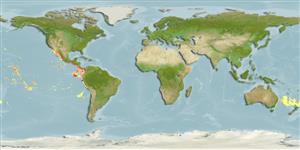>
Anguilliformes (Eels and morays) >
Congridae (Conger and garden eels) > Bathymyrinae
Etymology: Chiloconger: Greek, cheilos = lip + Latin, conger = conger (Ref. 45335).
More on author: Garman.
Environment: milieu / climate zone / depth range / distribution range
Ökologie
seewasser demersal; tiefenbereich 27 - 2198 m (Ref. 58018), usually 27 - 247 m (Ref. 96339). Tropical
Eastern Central Pacific: western coast of Mexico, Central and South America from the southern Gulf of California to Colombia. Not recorded from any of the oceanic islands of the eastern Pacific.
Size / Gewicht / Alter
Maturity: Lm ? range ? - ? cm
Max length : 30.0 cm TL Männchen/unbestimmt; (Ref. 9292)
Rückenflossenstacheln (insgesamt): 0; Afterflossenstacheln 0; Wirbelzahl: 118 - 122. Moderately elongate, small species with short, bluntly-rounded snout and a dark margin on the dorsal fin anteriorly. Preanal lateral line pores 19-27, predorsal length 20-26% TL (Ref. 50529). Caudal fin broadly rounded (Ref. 50529).
Adults are secretive and bottom-dwelling and prefer soft substrata where they can burrow with their tails (Ref. 28023). Oviparous, with planktonic leptocephali (Ref. 35590).
Life cycle and mating behavior
Geschlechtsreife | Fortpflanzung | Ablaichen | Eier | Fecundity | Larven
Smith, D.G. and E.S. Karmovskaya, 2003. A new genus and two new species of congrid eels (Teleostei: Anguilliformes: Congridae) from the Indo-West Pacific, with a redescription and osteology of Chiloconger dentatus. Zootaxa 343:1-19. (Ref. 50529)
IUCN Rote Liste Status (Ref. 130435)
Bedrohung für Menschen
Harmless
Nutzung durch Menschen
Mehr Information
ReferenzenAquakulturAquakultur ProfilZuchtlinienGenetikElectrophoresesVererbbarkeitKrankheitenVerarbeitungNutrientsMass conversion
Tools
Zusatzinformationen
Download XML
Internet Quellen
Estimates based on models
Preferred temperature (Ref.
123201): 12.3 - 26, mean 16.2 °C (based on 74 cells).
Phylogenetic diversity index (Ref.
82804): PD
50 = 0.7500 [Uniqueness, from 0.5 = low to 2.0 = high].
Bayesian length-weight: a=0.00110 (0.00044 - 0.00274), b=3.07 (2.85 - 3.29), in cm total length, based on LWR estimates for this (Sub)family-body shape (Ref.
93245).
Trophic level (Ref.
69278): 3.8 ±0.7 se; based on size and trophs of closest relatives
Widerstandsfähigkeit (Ref.
120179): hoch, Verdopplung der Population dauert weniger als 15 Monate. (Preliminary K or Fecundity.).
Fishing Vulnerability (Ref.
59153): Low vulnerability (20 of 100).
